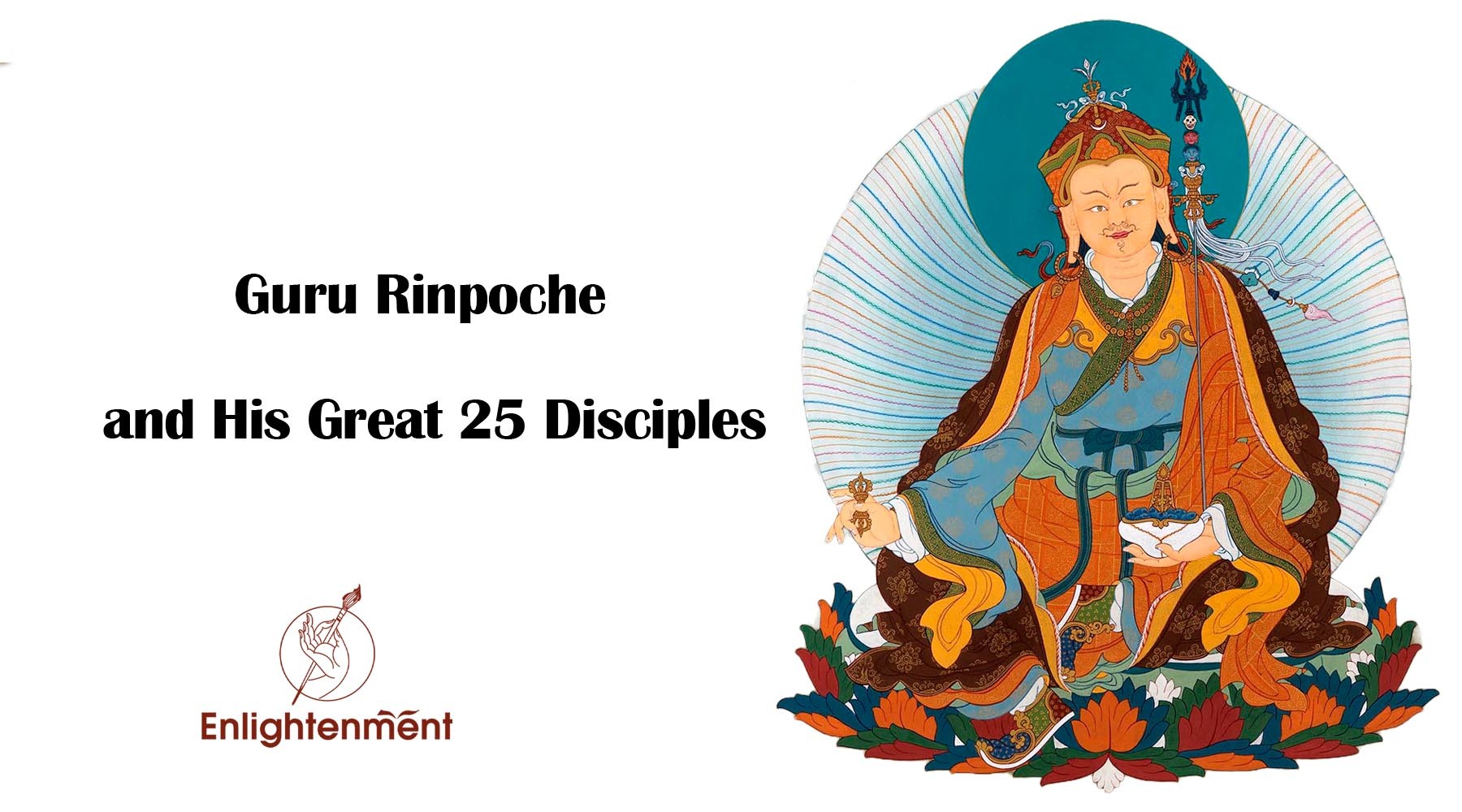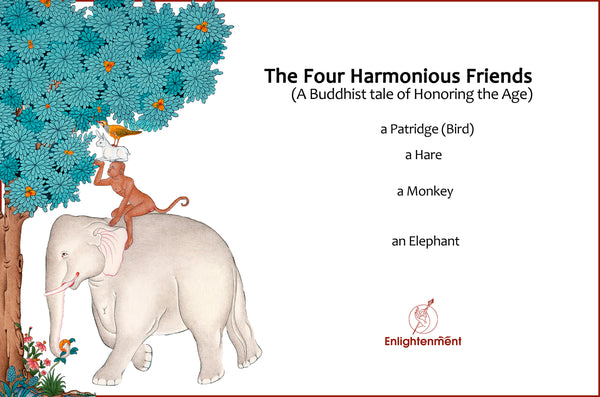Journey of Enlightenment: Meet the 25 Disciples of Guru Rinpoche
Guru Rinpoche, often referred to Padmasambhava is a highly revered sage of Vajrayana Buddhism and a fully enlightened Buddha. He was solely born through the power of his wisdom and compassion to serve infinite sentient beings. He is regarded as a Buddha who Buddha Shakyamuni prophesied.
During the 9th century, Padmasambhava visited Tibet as King Trisong Deutsen invited him. This visit is considered the introduction of Buddhism in Tibet for the first time. He then subdued both living and non-living creatures that were hindering the construction of the Samye Monastery. He battled the spirit forces on the peak of Hepo Mountain, not far from Samye Monastery, and bonded them to swear allegiance to the Dharma and its adherents.
He visited Tibet's valleys, Nepal, Bhutan, and Sikkim, and blessed them as "Sacred Land." Even more astoundingly, while he taught his followers these esoteric truths, he mysteriously hid them in the innocence of their minds. Then he hid several religious artifacts and symbolic writings in various locations, including rocks, sculptures, lakes, and outer space. His renowned Terma, or "Hidden Treasure Teachings," refers to these covert teachings.
He, along with his inner circle, preached about Buddhism. His yogic and philosophical teachings were the cornerstone of the Nyingma, an early Tibetan Buddhist order. All Tibetans refer to him as Guru Rinpoche because of his significant contribution to the spread of Buddhism in Tibet.
25 Disciples of Guru Rinpoche
These 25 disciples were behind the flourishment of Buddha's teachings in various part of Tibet. They resurfaced as masters, having attained great experience, insight, knowledge, and success.
Guru Rinpoche had many disciples during his journey of teachings. He mainly had 25 disciples who attained rainbow bodies (except Trisog Detsen) and were the first mahasiddhas of Tibet. These 25 Mahasiddhas are thought to have particularly significant future incarnations because they were destined to find Padmasambhava's terma treasures.
To this day, these 24 disciples continue to reincarnate as Tertons, passing on the teachings of Padmasambhava in a pure and modern manner to new generations.
Click To View Our Guru Rinpoche with 25 Disciple Thangka: 
- King Trisong Detsen [ khri srong lde'u btsan]
King Trisong, the 38th king of Tibet, is one of the greatest disciples of Guru Rinpoche. He is also responsible for the introduction of Buddhism in Tibet. The great masters Shantarashita and Guru Padmasambhava came to Tibet from India to establish Buddhism. It was due to the efforts and requests of King Trisong.
- Namkhé Nyingpo [nam mkha'i snying po]
Namkhé Nyingpo is one of Guru Rinpoche's highly devoted students. He received his ordination as a monk from great teacher Shantarakshita. He learned Sanskrit and visited India multiple times to study with Humkara and other great instructors. Guru Rinpoche was empowering him in the Samye Chimpu caves. He attained supreme mastery through worshiping this specific deity and was able to ride on beams of the sun.
- Nupchen Sangye Yeshe [gnubs chen sangs rgyas ye shes]
Nupchen Sangye Yeshe is said to have lived for 113 years, and some even speculate he lived for 130 years. He translated several tantras and brought the Anuyoga teachings to Tibet. He also studied under Vimalamitra and many other great teachers. When pursuing Buddhist devotees in Tibet, King Langdarma is said to have spared the common Tantrikas because of his supernatural abilities.
- Gyalwa Chokyang [rgyal ba mchog dbyangs]
Gyalwa Chokyang was also ordained as a monk by great master Shantarakshita similar to Namkhé Nyingpo. Kagyé's flower landed on the mandala of Hayagriva as Guru Rinpoche was empowering him in the Samye Chimpu caves. He was able to transform himself into a deity all credited to his practice. Then he heard a horse's neigh on the crown of his head.
- Khandro Yeshe Tsogyal [ye shes mtsho rgyal]
Khandro Yeshe Tsogyal has often referred to as the 'Victorious Ocean of Knowledge' or 'Knowledge Lake Empress.' She was the highest woman in the Nyingma Vajrayana lineage and attained enlightenment within her lifetime, and also considered as 'Mother of Tibetan Buddhism.' Also a Vajravarahi in human form and an emanation of Tara and Buddhalochana, she is the principal consort of Guru Padmasambhava.
- Palgyi Yeshé [dpal gyi ye shes]
Palgyi Yeshé was born at Yadrok in Drokmi Clan. He had studied under Ma Rinchen Chok (rma rin chen mchog), and Nyak Jñānakumara was his primary religious master. He is responsible for translating numerous tantra, especially those of Mamo Bötong. It led him to a supreme accomplishment.
- Langchen Palgyi Seng [rlangs chen dpal gyi seng ge]
Lanfchen Palgyi Seng is known for his attainment of both ordinary and supreme accomplishments through the practice of Jikten Chötö. He was one of 108 translators who were sent to India and Oddiyana.
- Vairotsana [bai ro tsa na]
Practitioners perceive Vairotsana as the most outstanding Tibetan lotsawas translator. He showed incredible intelligence at an early age and extraordinary skills, including the ability to fly through the air and read people's thoughts. Just like Gyalwa Chokyang and Namkhé Nyingpo, he was also ordained as a monk by great master Shantarakshita. Alongside Padmasambhava and Vimalamitra, he was one of the three principal gurus who introduced the Dzogchen teachings to Tibet.
- Nyak Jñanakumara or Yeshé Shyönnu [gnyag dz+nyA na ku ma ra]
Nyak Jñanakumara is one of several Tibetan monks and a skilled translator who received the Four Great Rivers of Transmission from Yudra Nyingpo, Vimalamitra, Padmasambhava, and Vimalamitra. He translated the Tantra of Mahayoga and Ati Yoga in close collaboration with Vimalamitra. He also goes by the names Nyag Lotsawa and Drimey Dashar, which means "Flawless Moonlight,". He is one of seven monks who Shantarakshita ordained.
- Gyalmo Yudra Nyingpo [g.yu sgra snying po]
Gyalmo Yudra Nyingpo was an outstanding scholar and translator who studied under Vairotsana, Vimalamitra, and Padmasambhava. He is one of the primary lineage bearers of the Mind Section of Dzogchen from the great translator Vairotsana and is numbered among the 108 lotsawas translators. He translated many books, including the latter thirteen of Semde's original 18 texts.
- Nanam Dorje Dudjom [sna nam rdo rje bdud 'joms]
Nanam Dorje Dudjom was one of the ministers dispatched by King Trisong Detsen to invite Guru Rinpoche to Tibet. Upon receiving empowerment from Padmasambhava, his flower landed on Vajrakilaya's mandala. Through practice, he developed into a skilled mantrika, able to fly at the speed of the wind and pass through solid rock.
- Yeshé Yang [ ye shes dbyangs]
Yeshé Yang ("Melodic Wisdom" in Tibetan) was the principal writer for recording Padmasambhava's termas and a skilled yogi with the ability to soar to the heavenly regions on the wings of a bird. He was also a fully ordained monk.
- Sokpo Lhapal [ye shes dbyangs]
Sokpo Lhapal was a blacksmith by trade who received teachings from Guru Rinpoche and Nyak Jnanakumara. He could take hold of ferocious creatures of prey with his bare hands, a feat of Vajrakilaya practice. Pema Lhundrub Gyatso (1660-1727), the second throne holder of Palyul Monastery is considered to be one of the reincarnations of Sokpo Lhapal.
- Nanam Shyang Yeshé Dé [sna nam zhang ye shes sde]
Nanam Shyang Yeshé Dé, together with Surendrabodhi, translated the Madhyamakalankara. He helped translate more than 300 hundred texts, including the Prajnaparamita Sutras, Tantra, Dharanis, treatise on Madhyamika, and Chittamatra which currently exist in the Kangyur and Tengyur.
- Kharchen Palgyi Wangchuk [mkhar chen dpal gyi dbang phyug]
Kharchen Palgyi Wangchuk meaning 'Resplendent Lord,' was a brother of Yeshe Tsogyal who attained enlightenment with the practice of Vajrakilaya.
- Denma Tsémang [ldan ma rtse mang]
Denma Tsémang was a renowned Tibetan calligrapher and Sanskrit translator. He is credited for creating a new unique calligraphic style and even transcribing several termas. As a result of his vigorous practice, he gained the power of complete and perfect memory.
- Kawa Paltsek [ska ba dpal brtsegs]
Kawa Paltsek was born in Kawa, Phenpo valley. He received his ordination as a monk from s Shantarakshita and was considered one of the best Tibetan Translators. He was the first to transcribe the Bodhicharyavatara into Tibetan, together with Sarvajadeva. He was dispatched to India by King Trisong Detsen to invite Vimalamitra to Tibet.
- Shüpu Palgyi Sengé [shud phu dpal gyi seng ge]
Alongside Nanam Dorje Dudjom, Shüpu Palgyi Sengé was one of the ministers dispatched by King Trisong Detsen to invite Guru Rinpoche to Tibet. He received translation training from Padmasambhava and translated several Mamo, Yamantaka, and Kilaya teachings into Tibetan. He could break boulders and divide the flow of rivers with his dagger because of his success with Kilaya and Mamo.
- Dré Gyalwé Lodrö ['bre rgyal ba'i blo gros]
Dré Gyalwé Lodrö started as Gönpo, a dependable aide to Trisong Deutsen, and then took ordination under the name Gyalwey Lodrö. Gyalwey Lodrö translates to "Victory knowledge." After getting a transmission from Hungkara in India, he reached success and became an expert translator. Following the legend, he attained the vidyadhara degree of longevity and taught Buddhism to Rongzom Pandita Chökyi Sangpo (rong zom chos kyi bzang po) from 1012 until 1088.
- Khye'u Chung Lotsawa [khye'u chung lo tsA ba]
Khye'u Chung Lotsawa was born in the Drokmi clan. He is believed to be the manifestation of an Indian mahapandita. His moniker, which translates as "boy translator", came from his early exposure to Sanskrit. He continued to work as a householder and, after becoming Padmasambhava's student, mastered the early transmission tantra.
- Otren Palgyi Wangchuk ['o bran dpal gyi dbang phyug]
Otren Palgyi Wangchuk was a renowned scholar and Tantrika who attained siddhi by meditating on Guru Drakpo, Padmasambhava's wrathful nature. He is described in various important scriptures, such as 'Lady of the Lotus.' Born by Gyalwa Jangchup, Guru Rinpoche bestows the outward, inner, and hidden root sadhanas of the Mamos, the Newap, and the Legye, as well as pleading with him to practice in the Yerpa caves.
- Ma Rinchen Chok [rma rin chen mchog]
Out of 25 disciples, 7 were tested, Ma Rinchen Chok was one of them. He became a devoted pupil of Vimalamitra and helped him with the translation of the Guhyagarbha Tantra. Along with Vimalamitra, he also translated the 'Cittabindu Upadesha,' a work by the three renowned Siddhas Buddhaguhya, Lilavajra, and Vimalamitra.
- Lhalung Palgyi Dorje [lha lung dpal gyi rdo rje]
Lhalung Pelgyi Dorje was born in Dromto Gungmoche ('brom stod gung mo che), east of Lhasa on the north bank of the Kyichu River (skyid chu). He was in charge of eliminating the evil King Langdarma, freeing the man, and ending the persecution of Buddhism in Tibet. At the very end of his life, he obtained the rainbow body.
- Langdro Könchok Jungné-Langdro Lotsawa [lang gro dkon mchog 'byung gnas]
Langdro Könchok Jungné was one of important ministers of King Trisong Detsen. The renowned tertön Ratna Lingpa, Dzogchen Pema Rigdzin, and Jamyang Khyentse Wangpo, who is thought to be his active emanation, are among his principal reincarnations.
- Lasum Gyalwa Changchup [la gsum rgyal ba byang chub]
Lasum Gyalwa Changchup was one of the first seven Tibetans to receive full ordination as a monk from Shantarakshita. He was knowledgeable, made multiple trips to India, and translated some holy texts. He was a close student of Padmasambhava, gained siddhi, and could fly. One of his reincarnations is thought to be Rigdzin Kunzang Sherab, the founder of the famous Palyül Monastery in Kham.
Also read our Blog on the Eight Manifestation of Guru Rinpoche:


